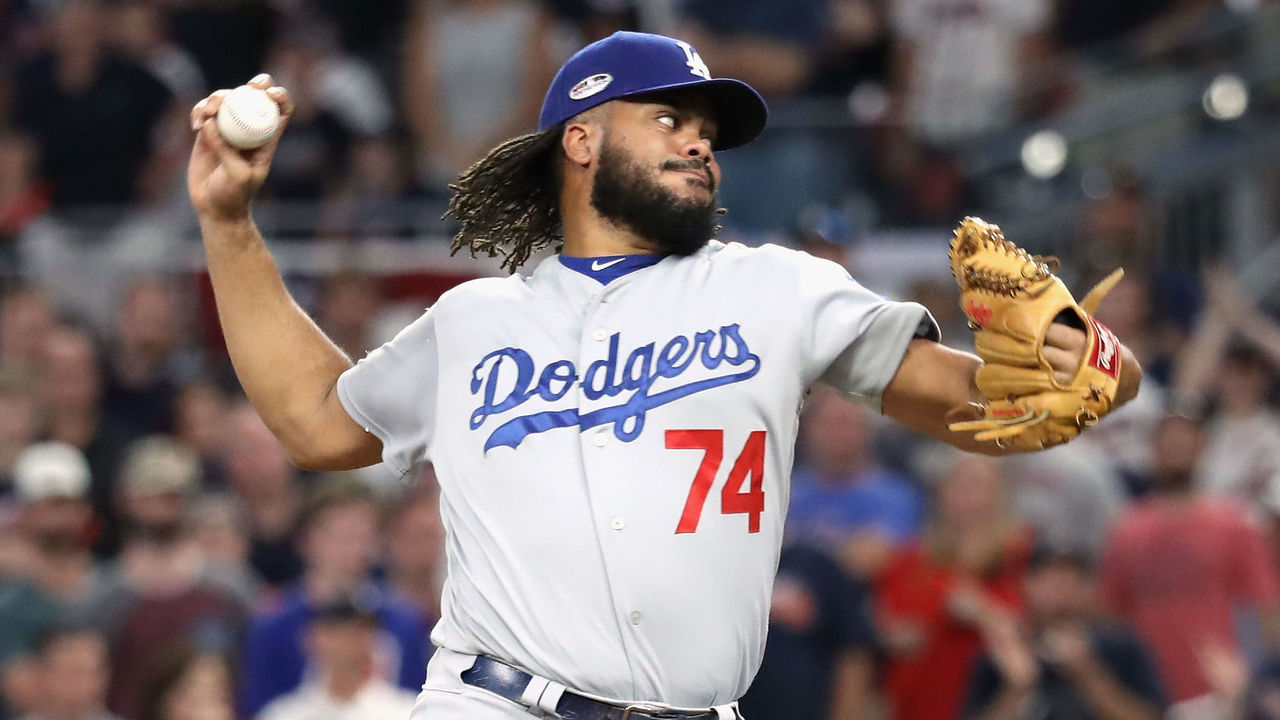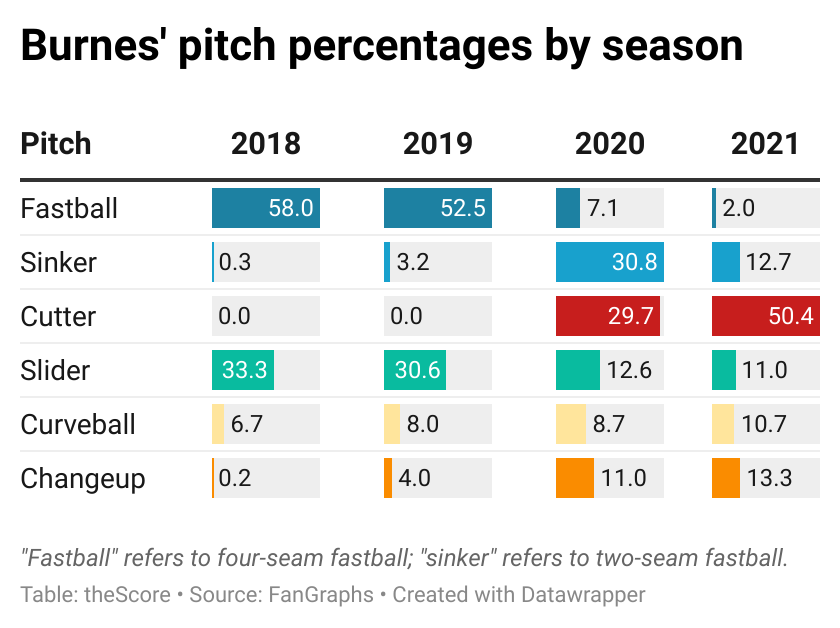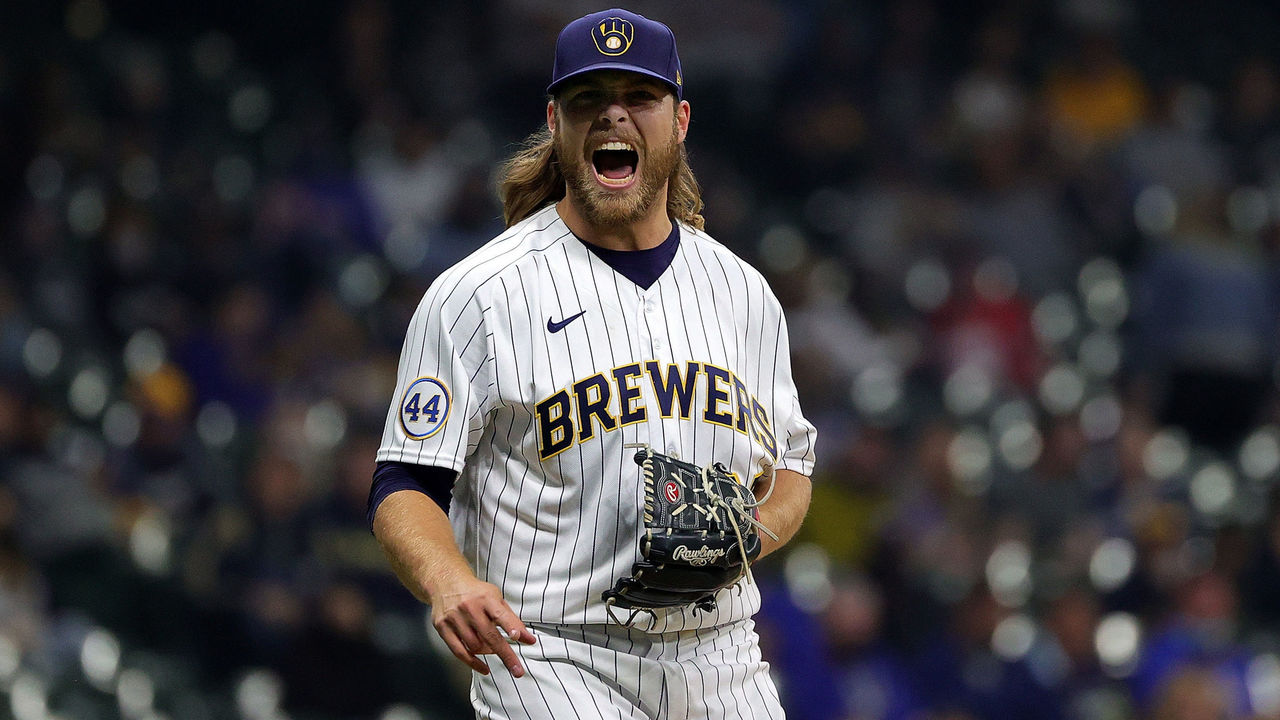Corbin Burnes needed one small tweak to go from the shadows to the spotlight
In the bottom of the first inning Tuesday night in San Diego, Padres leadoff hitter Trent Grisham struck out by swinging over the top of a darting 97-mph pitch from Milwaukee Brewers starting pitcher Corbin Burnes. As Grisham walked back to the dugout, the Padres’ broadcast team relayed the conversation the field microphone picked up. The next batter, Jurickson Profar, asked Grisham to verify what that pitch was.
"In? Cut?" asked Profar.
"Yes, exactly," Grisham said.
But the pitch seemed to move faster and break later than physics should allow. Despite having a good idea of what was coming, Profar followed by pounding another Burnes cutter into the turf for a groundout.
Burnes threw six shutout innings on the night, striking out 10 and walking none, bringing his season strikeout-to-walk ratio to 40-0, an MLB record to begin a season for a starting pitcher. Just over half his pitches were cutters, in line with his usage on the season.
Burnes lowered his ERA to a major league-best 0.37, which is remarkable since it was 8.82 in 2019, nearly the league's worst. Throughout Tuesday's outing, the 26-year-old with the dishwater-blonde mullet showed little emotion as he dominated San Diego and stalked around the mound after strikeouts. The rest of the baseball world is in awe.
Burnes' cutter is a unicorn pitch. He developed and added it to what is now a one-of-a-kind arsenal. Batters are helpless.
The following is the list of pitchers in the Statcast era who've thrown cutters with similar above-average vertical movement and horizontal darting action and who've averaged at least 94 mph:
- Burnes in 2021
- Kenley Jansen in 2016
That’s it. That’s the list.

Cleveland’s Emmanuel Clase also throws what some systems classify as a 100 mph cutter, though it doesn't quite fit the movement profile. Burnes’ 2021 cutter moves 2 mph faster than peak Jansen velocity. Burnes is also a starter; Jansen and Clase are relievers. While Burnes now owns the record for Ks without a walk to begin a season as a starter, he's chasing Jansen for the overall mark set in 2017, when Jansen struck out 51 batters before issuing a walk.
Like the Jansen cutter, or the Mariano Rivera variant, one of the benefits of a great cutter is it can be thrown regularly. Batters know it's coming and yet can't do much with it. It's given Burnes confidence to pepper the strike zone, reducing the walk issues he's had in the past. Burnes owns excellent control of the pitch so far, throwing 103 of 175 cutters within the confines of the strike zone, per Statcast data.
Batters often whiff at the pitch, even when it's in the zone, including the following swing-and-miss from Minnesota's Luis Arraez, generally an excellent contact hitter.
Entering Wednesday, only three qualified pitchers held opponents to a lower contact rate on pitches in the strike zone, a number that shouts: "Here it is. Try and hit it." Those names: Jacob deGrom, Freddy Peralta, and Carlos Rodon.
Only five pitchers have compelled more batters to chase pitches outside the zone, like that offering above that broke Ian Happ's bat: Burnes, deGrom, Luis Castillo, Joe Musgrove, and Shane Bieber. Only deGrom and Burnes are on both lists.
How quickly Burnes' command of the cutter came together is partly a testament to the power of modern pitch design, theory, and unlocking potential.
Burnes told reporters last week that he wanted to throw a "tighter, harder" slider following his disastrous 2019. As the experiment evolved during spring training at the Brewers' Arizona complex and the pitching labs there, the Brewers decided to change the tighter slider to a close relative: the cutter.
"When we got into spring training, we realized it was going to be more of a cutter, and that's when we made a few tweaks," Burnes said. "'Let's make it an actual cutter versus a slider with some depth.'"
After all, Burnes already threw a quality slider and a curveball. Why not create a pitch with more velocity but a different shape? The new pitch could also reduce his reliance on a poor fastball.
Burnes' four-seamer was by far his worst pitch. Despite throwing it at 95 mph in 2019, it had below-average movement. It had less ability to fight gravity, because of how his grip imparted the pitch's spin. The pitch was crushed. Batters hit .402 and slugged .790 against it.
So in the spring of 2020, Burnes essentially took his four-seam grip and offset his hand slightly to the right of the ball. One of the best pitches in the majors was born - fast. He made a big improvement in the shortened season; his 8.82 ERA was down to 2.11 over 12 starts in 2020.
So far this year, he's relied on the cutter even more and rarely throws his four-seamer. At the moment, his cutter is the second-most valuable pitch in the majors (only Tyler Glasnow’s fastball is more valuable according to FanGraphs' run value). After another bit of refinement and increased usage, batters are hitting .098 against Burnes' cutter this season.

Baseball's a game of millimeters. The slightest change in a grip can alter the fortunes of a pitch or a career.
Burnes' adjustment isn't much different than the one Rivera made many years earlier. But Rivera's revelation was an accident. The search for a new pitch used to be one of feel, searching in the dark. Pitch-tracking technology now provides immediate feedback about pitch quality thanks to high-speed cameras that show the finest detail of fingertips releasing a pitch and how they influence a ball's spin. Like many clubs, the Brewers have invested heavily in giving their player development staff state-of-the-art tools. While not every pitcher can mimic the best grips due to the uniqueness of physical characteristics, the tools available today are certainly playing a role in the strikeout surge.
"With a few ball positioning things in the hand, we were able to take (the four-seam fastball) and basically it's the cutter," Burnes said. "When I throw it, I'm thinking through the process of throwing a four-seam fastball. For me, I think that's why it's become such an easy pitch. It's something I've thrown my entire life."

Burnes and the Brewers knew what they wanted to do. In designing a cutter, a pitcher essentially wants to tilt the spin axis of a four-seam fastball, which is more parallel to the strike zone, to an axis pointing more toward the zone, the way a football spins. That's known as gyroscopic spin.
Instead of slightly bearing in on right-handed hitters as four-seam fastballs usually do from a right-handed pitcher, known as arm-side run, the cutter slightly breaks the opposite way due to the forces acting on it. The slight change produced incredible results: a pitch that travels up to 98 mph with a tight, late break toward left-handed hitters. The pitch breaks like some pitchers' sliders only with elite fastball velocity. So that grip adjustment created a helluva pitch that fits in perfectly with his offerings.
What makes Burnes truly terrifying is that while Jansen and Rivera had one great pitch, Burnes throws four others in addition to the cutter.
The following is a list of pitchers who throw a cutter, slider, changeup, sinker, and curveball each with frequencies of 10% or more often: Burnes and the soft-tossing Brett Anderson.
That’s it. That’s the list.
Most of those pitches are quality offerings in a vacuum and how they play off each other enhances their performance. In addition to the cutter, Burnes began throwing a two-seam fastball last season that breaks in the opposite direction from the cutter and from Burnes’ excellent, swing-and-miss slider. Add in his curveball and changeup and he possesses multiple pitches that dart away from bats - all with different shapes and slightly different speeds. Few pitchers have some depth in their offerings. Burnes basically has a cheat code at the moment.
The pitch mix makes him platoon-proof. Righties are batting .077 against Burnes while lefties aren't fairing much better at .116.
Burnes is tapping into a concept known as spin mirroring, which is a fancy term for masking the spin of pitches so batters can't differentiate between them as easily. If a pitcher can pair two different pitches that share a similar spin axis, but that rotate with opposite spin direction, it makes it difficult for batters to identify the pitch types. For instance, if a pitcher had a perfect 12-to-6 downer of a curveball and a fastball with a perfectly straight, south-to-north vertical lift, the pitches would share the same spin axis and look similar for part of their journey toward the plate. Burnes is able to do that with various pitch pairings.
Otherwise, much of Burnes' profile is unchanged. He throws a bit harder, but not dramatically more so than he did in 2019. He doesn’t throw more pitches within the strike zone. But one big thing is different: the cutter is allowing his whole arsenal to play up. Essentially, a second deGrom-level performer is roaming the National League early this season. No one can pitch like Burnes, and no one can hit him.
Travis Sawchik is theScore's senior baseball writer. Follow him on Twitter at @Travis_Sawchik.